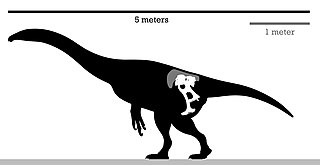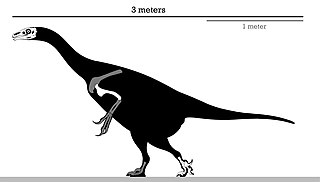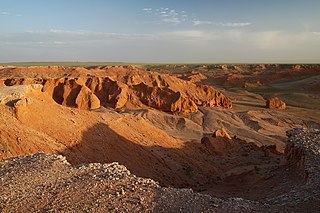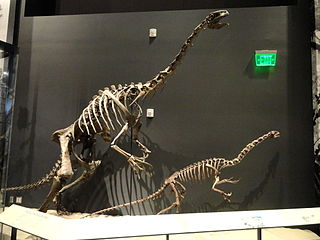
Segnosaurus is a genus of therizinosaurid dinosaur that lived in what is now southeastern Mongolia during the Late Cretaceous, about 102–86 million years ago. Multiple incomplete but well-preserved specimens were discovered in the Gobi Desert in the 1970s, and in 1979 the genus and species Segnosaurus galbinensis were named. The generic name Segnosaurus means "slow lizard" and the specific name galbinensis refers to the Galbin region. The known material of this dinosaur includes the lower jaw, neck and tail vertebrae, the pelvis, shoulder girdle, and limb bones. Parts of the specimens have gone missing or become damaged since they were collected.

Therizinosaurus is a genus of very large therizinosaurid that lived in Asia during the Late Cretaceous period in what is now the Nemegt Formation around 70 million years ago. It contains a single species, Therizinosaurus cheloniformis. The first remains of Therizinosaurus were found in 1948 by a Mongolian field expedition at the Gobi Desert and later described by Evgeny Maleev in 1954. The genus is only known from a few bones, including gigantic manual unguals, from which it gets its name, and additional findings comprising fore and hindlimb elements that have been discovered during the 1960s–1980s.

Therizinosaurs were large herbivorous theropod dinosaurs whose fossils have been found across the Early to Late Cretaceous deposits in Asia and North America. Various features of the forelimbs, skull and pelvis unite these finds as both theropods and maniraptorans, close relatives to birds. The name of the representative genus, Therizinosaurus, is derived from the Greek θερίζω and σαῦρος. The older representative, Segnosaurus, is derived from the Latin sēgnis ('slow') and the Greek σαῦρος.

Enigmosaurus is a genus of therizinosauroid that lived in Asia during the Late Cretaceous period. It was a medium-sized, ground-dwelling, bipedal herbivore that represents the third therizinosaur taxon from the Bayan Shireh Formation, although it is known from the lower part. The genus is monotypic, including only the type species E. mongoliensis, known from a well preserved pelvis and other tentative body remains.

Alectrosaurus is a genus of tyrannosauroid theropod dinosaur that lived in Asia during the Late Cretaceous period, about some 96 million years ago in what is now the Iren Dabasu Formation.

Adasaurus is a genus of dromaeosaurid dinosaur that lived in Asia during the Late Cretaceous period about 70 million years ago. The genus is known from two partial specimens found in the Nemegt Formation of Mongolia that were partially described in 1983 by the paleontologist Rinchen Barsbold.

Achillobator is a genus of large dromaeosaurid dinosaurs that lived in Asia during the Late Cretaceous period about 96 million to 89 million years ago in what is now the Bayan Shireh Formation. The genus is currently monotypic, only including the type species A. giganticus. The first remains were found in 1989 during a Mongolian-Russian field expedition in Mongolia and later described in 1999. Remains at the type locality of Achillobator may represent additional specimens. It represents the first and largest dromaeosaurid known from the Bayan Shireh Formation.

Bagaceratops is a genus of small protoceratopsid dinosaurs that lived in Asia during the Late Cretaceous, around 72 to 71 million years ago. Bagaceratops remains have been reported from the Barun Goyot Formation and Bayan Mandahu Formation. One specimen may argue the possible presence of Bagaceratops in the Djadochta Formation.

The Bayan Shireh Formation is a geological formation in Mongolia, that dates to the Cretaceous period. It was first described and established by Vasiliev et al. 1959.

Tsagantegia is a genus of medium-sized ankylosaurid thyreophoran dinosaur that lived in Asia during the Late Cretaceous period. The genus is monotypic, including only the type species, T. longicranialis. The specimen consists of a very partial individual, comprising the skull and lacking postcranial remains. Since it only preserves the skull, Tsagantegia is mainly characterized by its elongated snout and the flattened facial osteoderms, greatly differing from other ankylosaurs.

Erlikosaurus is a genus of therizinosaurid that lived in Asia during the Late Cretaceous period. The fossils, a skull and some post-cranial fragments, were found in the Bayan Shireh Formation of Mongolia in 1972, dating to around 96 million and 89 million years ago. These remains were later described by Altangerel Perle and Rinchen Barsbold in 1980, naming the new genus and species Erlikosaurus andrewsi. It represents the second therizinosaur taxon from this formation with the most complete skull among members of this peculiar family of dinosaurs.

Nanshiungosaurus is a genus of therizinosaurid that lived in what is now Asia during the Late Cretaceous of South China. The type species, Nanshiungosaurus brevispinus, was first discovered in 1974 and described in 1979 by Dong Zhiming. It is represented by a single specimen preserving most of the cervical and dorsal vertebrae with the pelvis. A supposed and unlikely second species, "Nanshiungosaurus" bohlini, was found in 1992 and described in 1997. It is also represented by vertebrae but this species however, differs in geological age and lacks authentic characteristics compared to the type, making its affinity to the genus unsupported.

The Barun Goyot Formation is a geological formation dating to the Late Cretaceous Period. It is located within and is widely represented in the Gobi Desert Basin, in the Ömnögovi Province of Mongolia.

The Nemegt Formation is a geological formation in the Gobi Desert of Mongolia, dating to the Late Cretaceous. The formation consists of river channel sediments and contains fossils of fish, turtles, crocodilians, and a diverse fauna of dinosaurs, including birds.

The Djadochta Formation is a highly fossiliferous geological formation situated in Central Asia, Gobi Desert, dating from the Late Cretaceous period, about 75 million to 71 million years ago. The type locality is the Bayn Dzak locality, famously known as the Flaming Cliffs. Dinosaur, mammal, and other reptile remains are among the fossils that have been recovered from the formation.

Caenagnathidae is a family of bird-like maniraptoran theropod dinosaurs from the Cretaceous of North America and Asia. They are a member of the Oviraptorosauria, and close relatives of the Oviraptoridae. Like other oviraptorosaurs, caenagnathids had specialized beaks, long necks, and short tails, and would have been covered in feathers. The relationships of caenagnathids were long a puzzle. The family was originally named by Raymond Martin Sternberg in 1940 as a family of flightless birds. The discovery of skeletons of the related oviraptorids revealed that they were in fact non-avian theropods, and the discovery of more complete caenagnathid remains revealed that Chirostenotes pergracilis, originally named on the basis of a pair of hands, and Citipes elegans, originally thought to be an ornithomimid, named from a foot, were caenagnathids as well.

Halszka Osmólska was a Polish paleontologist who had specialized in Mongolian dinosaurs.
The Khuren Dukh Formation, also known as the Hühteeg Svita, is a geological formation in Mongolia whose strata date back to the middle to late Albian. Dinosaur remains are among the fossils that have been recovered from the formation.

The timeline of therizinosaur research is a chronological listing of events in the history of paleontology focused on therizinosaurs. They were unusually long-necked, pot-bellied, and large-clawed herbivorous theropods most closely related to birds. The early history of therizinosaur research occurred in three phases. The first phase was the discovery of scanty and puzzling fossils in Asia by the Central Asiatic Expeditions of the 1920s and Soviet-backed research in the 1950s. This phase resulted in the discovery of the Therizinosaurus cheloniformis type specimen. Soviet paleontologist Evgeny Maleev interpreted these unusual remains as belonging to some kind of gigantic turtle.

Tsagandelta is a genus of deltatheroidean therian mammal that lived in Asia during the Late Cretaceous. Distantly related to modern marsupials, it is part of Deltatheroida, a lineage of carnivorous metatherians common in the Cretaceous of Asia and among the most successful non-theropod carnivores of the region. It represents the first known mammal from the Bayan Shireh Formation.




















